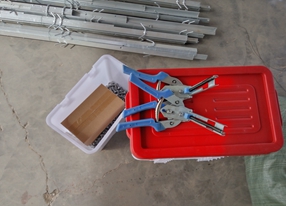chicken transport cage
Nov . 23, 2024 19:06 Back to list
chicken transport cage
The Importance of Chicken Transport Cages in Poultry Industry
In the poultry industry, the method of transporting chickens plays a vital role in ensuring their health, safety, and overall well-being. One of the essential components of this process is the chicken transport cage. These specially designed cages not only protect the birds during transit but also facilitate compliance with regulatory standards and improve the efficiency of transportation processes.
Design Features of Chicken Transport Cages
Chicken transport cages are typically crafted from sturdy materials, such as galvanized metal or high-density plastic, which provide durability and strength. The design often includes ventilation openings to promote airflow and maintain a comfortable temperature for the chickens. Additionally, many transport cages come with a secure locking mechanism to prevent escape and ensure the safety of the birds during transit.
The dimensions of these cages are crucial, as they must accommodate various sizes of chickens while allowing enough space for movement. Overcrowding can lead to stress and injury, so finding the right balance between efficiency and animal welfare is paramount. Standard industry regulations often dictate specific sizes and stocking densities to ensure that the chickens have enough room to stand, lie down, and turn around comfortably.
Transport Cage Types
There are several types of chicken transport cages, each suited for different purposes and modes of transportation. For instance, stackable transport cages are designed for efficiency and ease of handling, allowing multiple cages to be stacked securely during transportation. These are commonly used for long-distance transport by truck or rail.
Another common type is the portable transport cage, which is lightweight and designed for short trips, such as between farms or to processing facilities. These cages are often collapsible, making them easy to store when not in use. Some operations also utilize specialized cages for the transport of specific poultry breeds, ensuring that each type of chicken has a suitable environment during transit.
chicken transport cage

Importance of Welfare
Animal welfare is an increasingly important consideration in the poultry industry, and the use of proper transport cages is a significant aspect of this concern. According to numerous studies, improper handling and transport can lead to increased stress levels among chickens, resulting in higher rates of injury, illness, and mortality. By utilizing properly designed transport cages, poultry producers can significantly reduce these risks.
Additionally, the welfare of the chickens during transport is often under scrutiny by consumers and regulatory bodies. The use of appropriate cages that comply with animal welfare standards not only protects the birds but also enhances the reputation of the producers. Companies that prioritize animal welfare are likely to attract more customers who are increasingly concerned about ethical practices in food production.
Regulatory Compliance
The poultry industry is subject to various regulations aimed at ensuring the humane treatment of animals during transport. Governments around the world have established standards that pertain to the design and use of chicken transport cages. Compliance with these standards is necessary to avoid legal repercussions and potential penalties.
Transport cages must be equipped with features that minimize discomfort for the birds during transport. This includes not only ventilation but also considerations for temperature control and protection from extreme weather conditions. Moreover, proper labeling and documentation of the transport process can further facilitate regulatory compliance.
Conclusion
In conclusion, chicken transport cages serve a fundamental role in the poultry industry by providing a safe, efficient, and humane means of transporting birds. The design and implementation of these cages have a direct impact on the welfare of the chickens, which is increasingly important to producers and consumers alike. As the industry continues to evolve, the focus on improving transport conditions and adhering to animal welfare standards will likely remain a priority, making chicken transport cages an essential aspect of modern poultry production. Proper investment in these transport systems not only enhances the welfare of the chickens but also supports the growth of a sustainable and ethically responsible poultry industry.
-
Automatic Feeding Line System - Anping Yize | Efficiency&Durability
NewsJul.29,2025
-
Automatic Feeding Line System - Anping Yize|Poultry Efficiency&Durability
NewsJul.29,2025
-
Automatic Feeding Line System-Anping County Yize Metal Products Co., Ltd.|Durable PP Material&Easy Maintenance
NewsJul.29,2025
-
Automatic Feeding Line System-Pan Feeder Nipple Drinker|Anping County Yize Metal Products Co., Ltd.
NewsJul.29,2025
-
Hot Sale 24 & 18 Door Rabbit Cages - Premium Breeding Solutions
NewsJul.25,2025
-
Automatic Feeding Line System Pan Feeder Nipple Drinker - Anping County Yize Metal Products Co., Ltd.
NewsJul.21,2025






